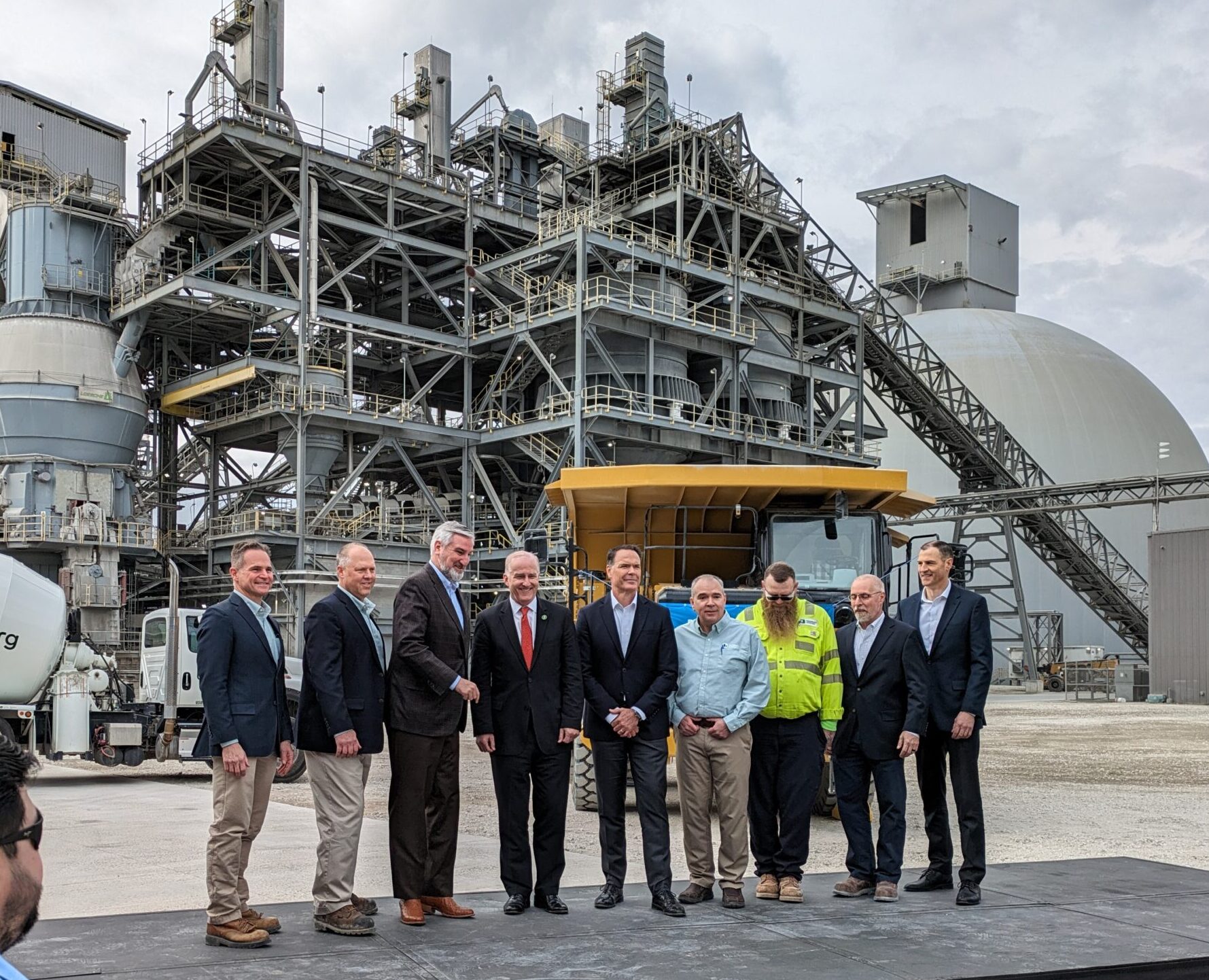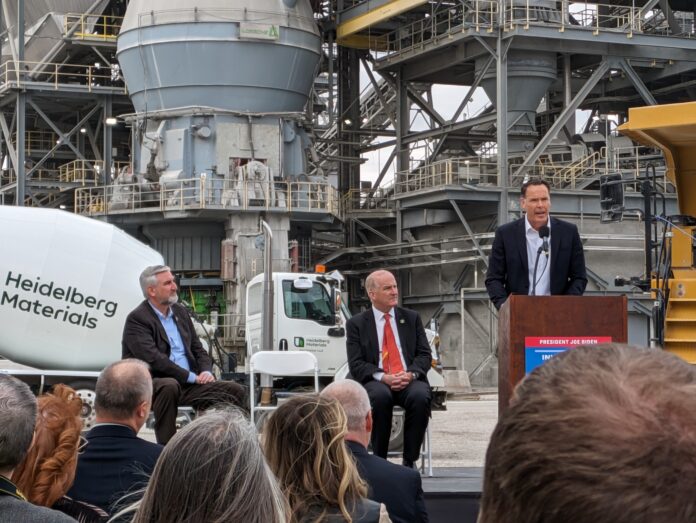Carol Johnson, Southern Indiana Business Report
MITCHELL – Heidelberg Materials is accelerating its carbon capture efforts at its Mitchell plant with the announcement that it will receive up to $500 million in federal funds to construct a carbon capture and storage system.
Heidelberg on Monday held a gathering of local, state and federal officials to announce this next phase in its plans to further reduce carbon dioxide emissions. Indiana Gov. Eric Holcomb and Department of Energy Under Secretary David Crane were among those in attendance.
The gathering at the Mill Creek Road plant coincided with the United States Department of Energy’s announcement that $6 billion is being awarded to 33 projects across 20 states to reduce industrial emissions.
The new investment comes one year after Heidelberg completed construction of a new $600 million plant that significantly reduced its carbon dioxide emissions and energy consumption while also increasing production levels.
At a large gathering in 2023 to celebrate the new plant, Heidelberg Materials CEO Dominik von Achten said the new plant would be “the springboard to becoming the first fully decarbonized cement plant in the U.S. It represents our commitment to further strengthening our North American footprint and increasing the sustainability of our products.”
The DOE investment was described as critical to implement the project.

“This is the way we can get to zero. The investment we celebrated a year ago modernized our plant to reduce our cement intensity by over 30%,” said Chris Ward, Heidelberg Materials North America president and CEO. “We will not get to zero without the addition of a carbon capture and sequestration plant and that’s what this investment from the federal government is allowing us to do now.”
The proposed CCS project will capture, treat and prepare for storage or use approximately 2 million tons of CO2 each year from the cement plant.

What is carbon capture?
Carbon capture removes carbon dioxide from large emission sources. The purpose of carbon capture is to limit emissions by capturing and storing it safely, such as in underground geological formations. The process of capturing, transporting and storing carbon emissions is referred to as carbon capture and storage, CCS.
Heidelberg’s Mitchell plant covers over 2,000 acres, providing ample space for a CCS system.
The fact that the Mitchell plant is state-of-the-art and designed for efficiency made it the ideal plant for a CCS, said Ward. The southern Indiana topography with its sinkholes and caves also is geographically well suited for a CCS.
“We believe the conditions and geology around here are conducive to storage because many of our plants don’t have the ability to store in a close proximity. We believe the transport costs of the CO2 will be on the lower side,” Ward said.
The pre-feasibility engineering for the CCS has already begun using an amine-based solvent capture technology. According to a fact sheet from Heidelberg, testing of this technology has confirmed a carbon capture rate of 95% or higher, which is above current industry standards.
“We’re so excited to have the Mitchell plant here and to be able to add on to that something that will make us the most environmentally friendly cement plant in the United States is sure exciting,” said Tracy Crowther, plant manager of Heidelberg in Mitchell.
Safety FAQs
Underground injection of carbon dioxide is regulated by the US Environmental Protection Agency. The Indiana Department of Natural Resources issues a permit to store CO2 with long-term monitoring.
In Indiana, the average depth of a drinking weather well is about 150 feet. Carbon storage occurs at significant depths, often more than a mile beneath the surface, where it is isolated from shallow groundwater and surface water sources.
Why CCS is important
About one-third of emissions from cement manufacturing comes from the fuel combustion required to achieve temperature to produce cement. Reducing these emissions can be accomplished by using low-carbon fuels and renewable fuels.
The Mitchell facility has shifted to 100% natural gas, which has resulted in a double-digit net reduction per ton of product.
About two-thirds of carbon emissions from cement manufacturing come from the chemical conversion of limestone into the final project. These emissions will be addressed via CCS.
Benefits of project
A carbon capture system improves local air quality by reducing the amount of carbon dioxide, sulfur dioxide and nitrogen oxides.
The project will benefit the economy with the creation of 1,000 construction jobs and 20-25 full-time jobs.
Investing in America
The DOE announcement is part of President Biden’s Investing in America agenda.
Funded by Biden’s Bipartisan Infrastructure Law and Inflation Reduction Act, the projects will create and maintain tens of thousands of high-quality jobs and help accelerate the commercial-scale demonstration of emerging industrial decarbonization technologies crucial to meeting the Biden-Harris Administration’s climate and domestic manufacturing goals.
The projects will focus on the highest emitting industries where decarbonization technologies will have the greatest impact, including aluminum and other metals, cement and concrete, chemicals and refining, iron and steel, and more.
Together, the projects are expected to reduce the equivalent of more than 14 million metric tons of carbon dioxide (CO2) emissions each year, an amount equivalent to the annual emissions of 3 million gasoline-powered cars.
Monday’s DOE announcement is the largest investment in industrial decarbonization in American history, helping to position American manufacturers and workers to lead the global clean energy economy.



